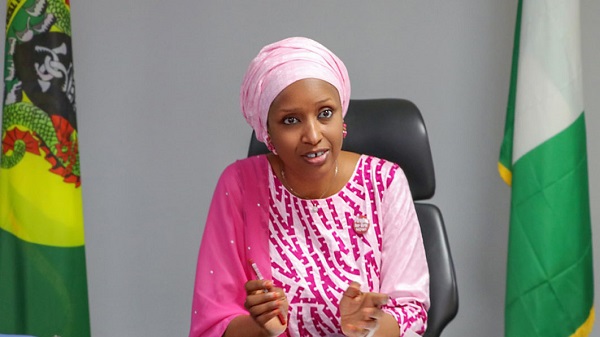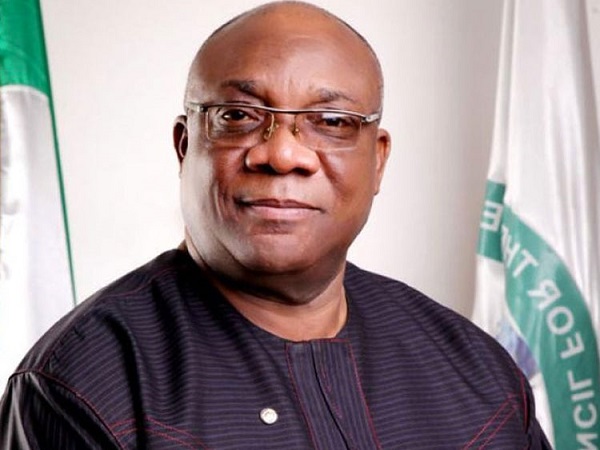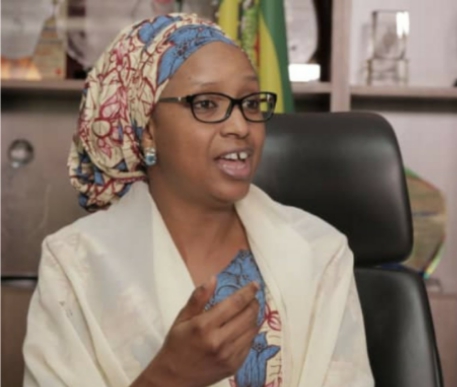Eto: Challenges Are Surmountable, We’ll Fix Them – NPA

By Yusuf Odejobi
The Managing Director of Nigerian Ports Authority (NPA) Hadiza Bala-Usman had a chat with newsmen recently. She spoke on the modest success as well as challenges of the new electronic truck call-up system (Eto) since its inception. Usman also commented on several pertinent issues in the nation’s maritime sector. Enjoy it:
What necessitated the need for creating an Electronic call-up system “Eto” and how would you rate the impact so far?
Eto is an e-platform that seeks to provide solutions to traffic congestion. It’s a platform where an importer can login and access; a platform where trucks are scheduled given the necessary approval to go into the port in an orderly manner. It’s just to sequence and ensure sanity in the port corridor.
Within the framework of Eto there are designated and approved truck parks where all trucks can wait before they approach the port corridor; we also have the truck pass and pre-gate. Pre-gate is just like the last bus stop before the trucks get into the port location. This is all done to remove human intervention and remove the several layers of bureaucratic bottlenecks in the system. Several task forces have been put in place, but they find it challenging to provide that sanity that we all require within the port corridor.
Another key aspect of the Eto platform is the deployment and compliance with approved truck parks. The electronic part is the idea of taking away from any person that determines who comes into the port or not. One of the things that I always reference is that the trucks should remain at the approved truck park when the port is not ready for them. They should not come to the roads and make our highways their parking space. The platform is laid with respective terminal operators who convey the readiness of vessels to pick up cargo that are coming from outside.
There have been reports that the Eto system was hacked by scammers resulting in selling fake call up notices, how true is that?
The aspect of hacking is incorrect, it was not hacked. We have strengthened our mechanism to ensure that fake call-up is not applicable. We have noted all manners of trying to circumvent the e-call up, and we resolved to concentrate on it. In the last one week you’ll see that a lot of trucks have built up which led to the front cover news by a national daily that we actually suspended the trucks accessing the port that has export cargo. So, for the next two weeks all export cargoes would not be allowed access into the port. We have a backlog of over 600 trucks that have approached the port coming out of the truck parks and are currently within the port corridor and Lilypond. We have noted the challenges we have with export cargo which resulted in this congestion. We realized that a lot of export cargoes approached the port without completing their documentation; in terms of readiness of terminal operators to receive them. For some, their certificates are not complete like certificates required from supervisory agencies based on the type of export they are carrying, Customs and CBN certifications. Recognizing that there is a problem, I’ve invited the Nigerian Export Promotion Council (NEPC) and within the next two weeks, they will join us to meet with the large exporters to make them understand the procedures with regards to their documentation. It’s important they know that if any of their documentation is not complete they shouldn’t even start their journey to access the port.
One of the problems leading to delays in cargo evacuation from the ports is the manual inspection of cargoes and neighbouring countries are profiting from the infrastructure challenge at Nigerian ports. What is being put in place to reduce the amount of time cargoes spend at the ports?
That is also a key aspect that we have been engaging the Nigeria Customs Service (NCS). Nigerian Customs is required to provide the scanners; we have started the procurement process and they’re committed to conclude it in 2021 so that scanners can be deployed with the port corridors. The integral part of the delay is where Customs have to physically inspect the cargoes, but we also have at the port gates for another layer of checking which makes the process even slower.
Another important issue is export and we have identified all the corridors for respective inflow of trucks into the port. We’ve also identified the reefer trucks, those are the perishable exports and those trucks that are conveying fishes in and out of the port which are given priority based on their nature. We have issued a statement on this, for all export cargoes aside from perishables to not go into the port, but remain at their location till we conclude on the framework with which they would come in.
Eto app has reached over 5000 downloads from the Google play store giving us an average of 166 downloads daily. Does this represent success after one month considering the volume of traffic at the port and how soon before we are able to use Eto effectively to remove all the backlogs?
Like I said as it relates to export cargoes, we’re giving them a two week window to understand the requirements as a framework. So, we should be able to clear the trucks within the next one week to 10 days, and then we can have clarity as regards seamless inflow and outflow of trucks. In furtherance to that, we have also given ourselves a corridor of 3 months with which all stakeholders would be able to understand and recognize the operations of the Eto platform.
So far, we believe it’s a success and with such a huge project definitely challenges would come up and also those challenges have not been surmountable, we also had collaborations with the Lagos State government. I would like to commend the Governor for the support in enforcement that he has given this project and I believe together with strengthened collaboration from other stakeholders, we will be able to achieve outstanding results.
Are we saying that if every truck driver understands the documentation process to get in and out of the port and follows due process as outlined in the Eto app, traffic congestion around the port corridor would be history?
It’s beyond the truck driver because this process also has to do with the transporter and the owner of the cargoes. That is why we escalated it to NEPC, the owner of that export needs to understand what is required. There is a certain extent to which a transporter or the agency gives certain information about what is required and the owner would just be sitting in the office with the thought that the goods are on the way to the port without realizing that the documentation should have been done before the goods departed the facility.
So, stakeholder awareness and consciousness of what is required is something we definitely need to do. A lot of rent seeking has been going on in the port corridor across the security agencies including NPA, so we’re going to receive push backs from that and keep on removing the interventions.
Is there a sustainability plan for when you leave office with regards to this project such that when the next person comes in he/she would stick to the original plan or make improvements and not a complete change?
We do have that and that is the success of this project as all stakeholders would bear witness to it, such that even if someone tries to change it there would be tremendous push back. We have also tried to institutionalize it, but I’ve always said that the success of a project is what keeps it alive. We have to ensure that we keep a full cycle of the project and the stakeholders are able to see it as a success.
The bad roads leading to the port is also a contributing factor to the gridlock in that area and Dangote is doing that in exchange for tax holidays. But many say that fixing the road would not necessarily solve the traffic situation in that corridor. In addition to the Eto platform and fixing the road, what are other issues that need to be addressed to ensure the traffic around that corridor is solved?
Yes, there’s ongoing construction in that axis. I spoke with the Minister of Works recently to ensure that we hasten the process and also prioritize rehabilitation as regards patching of areas needed. But importantly, we must have intermodal transportation for cargoes which is key.
If you imagine 1.3million TEUs coming into our port all plying our roads, it’ll definitely result in congestion and roads will become bad due to the tonnage of trucks that ply the road. So we’re going to utilize inland waterways and have the rail functional. The rail projects have been extended to Apapa port and with that we’ll have more of the cargoes going via the train. Railway is very strategic for cargo movement and if we prioritize that with the bulk of the cargo going on rail and others via the inland waterways, then it’ll be a success. We’ve had meetings with National Inland Waterways Authority (NIWA) on barge operations from Lagos to Onitsha and we’re also working with all stakeholders. Within the next 3 months we’ll be able to have clarity on its implementation.
From Onne to Onitsha port, containers are already being loaded on barges. So, I’m definite that the intermodal transport system is the solution we have to adopt.
Tank farms are also another integral part of the port congestion within the port axis and their regulatory oversight isn’t covered by the NPA. This is an issue because liquid bulk should actually be evacuated through pipelines. When you have all those trucks approaching the Apapa corridor for petroleum products is another reason that leads to congestion. I believe with the Eto platform, the reconstruction of the road and as a country we must consciously recognize that intermodal systems for cargo evacuation are what we need to address.
NRC has hastened the railway from the port to other parts of the country; do you know when that would go into full service?
I don’t have a timing exactly but I’m sure it’s within the shortest period. Arrangements are being made with Mr. President to commission the projects. NRC will be in a better position to give a specific date but this is exciting. We are also looking at Tin Can Island port having rail access and that will significantly reduce the volumes you see on the road. When you look at the landmass and population of a state like Lagos, we must consciously try to use other modes of transportation beyond land to reduce traffic congestion within the port corridors and everywhere.
What’s the update as regards the operation of illegal barging?
People are using illegal jetties and badges as entry points into the town, but we’ve determined that the jetties are allocated by the Federal Ministry of Works.
Ship abandonment poses a threat to aquatic life, what is being done to evacuate those abandoned ships on our waterways and also stop further abandonment?
We’ve gone through the process because there is a legal process required when it comes to abandoned vessels. We did marine notice to notify the owners of those vessels to one forward, the deadline has expired but they haven’t come forward. We’re going through the next step of auctioning those vessels.
The most important part of it is to institute a health insurance policy across all vessels including those carrying the Nigerian flag. That would be if you abandon your vessel, insurance would come forward to take it up. We’ve concluded that we are directed by the Ministry of Transportation to forward it to NIMASA who is the agency that would institute the health insurance policy.
What is NPA doing to ensure other ports across the country are patronized?
On utilization of other ports across the country, I’ve encouraged vessels to call into Onne Port. We had the largest container vessel in Nigeria calling at Onne Port at the end of last year just to test to ensure that big vessels go there. We have reduced harbour dues for port locations in the Eastern corridor, Calabar and Warri to encourage vessel owners to go there.
In addition, the Lekki deep sea port is also coming up by end of 2022 and first quarter of 2023 also we’re going to have other aspects or alternatives where people can take their cargoes to.







